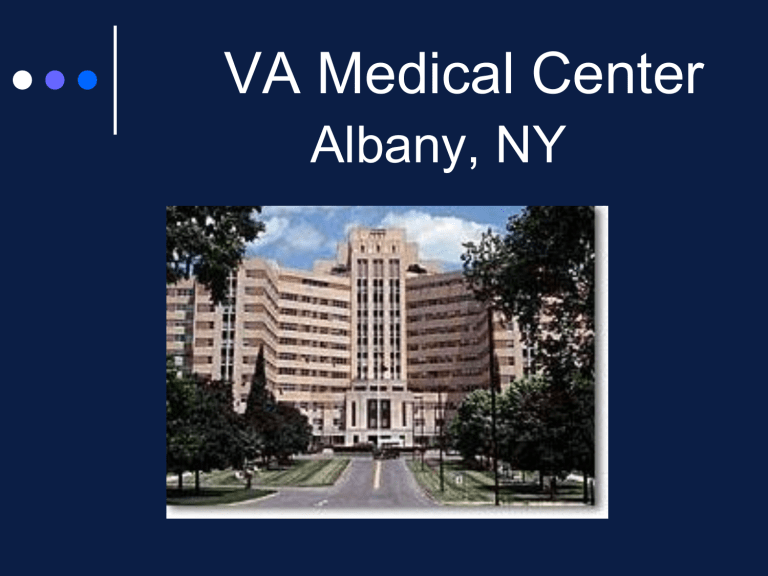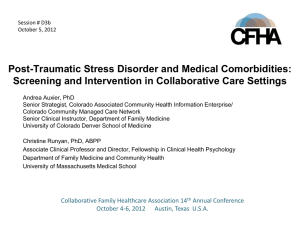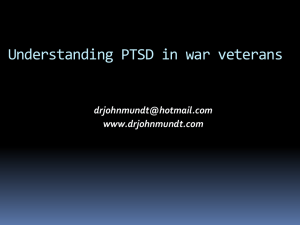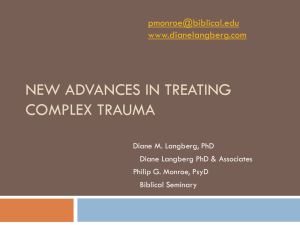A Conversation About PTSD - Two Towns

VA Medical Center
Albany, NY
Posttraumatic Stress Disorder:
Attachment Based Experiential
Interventions
May 16, 2013
Posttraumatic Stress Disorder
Program
Charles R. Kennedy, Ph.D., Gretchen Wilber, Psy.D.
History of Posttraumatic
Stress Disorder
PTSD is an anxiety disorder that can occur after experiencing or witnessing a traumatic event.
The person experienced, witnessed or was confronted by an event or events that involved actual or threatened death or serious injury or threat to physical integrity of self or others.
The person’s response involved intense fear, helplessness or horror.
Prediction of Imminent
Danger
What is the probability that you will face a life threatening event upon leaving today’s presentation?
PTSD Prevalence Rates
Most survivors of trauma return to pre trauma functioning over time
60.7% of men and 51.2% of women are exposed to trauma
5% males and 10% of females are diagnosed with PTSD
Some people have stress reactions that do not go away or get worse over time.
These individuals may develop PTSD
PTSD Prevalence Rates
Combat exposure is one of the traumas, along with sexual assault, most commonly associated with the development of PTSD (Kessler,
Sonnega, Bromet, Hughes & Nelson, 1995).
The estimated lifetime prevalence of PTSD for the general population is approximately 8%
(Keane, Weathers & Foa, 2000).
It is estimated that 15.2% of male Vietnam combat veterans currently suffer from PTSD and the lifetime prevalence for this population is estimated at 30.9% (Kulka et al., 1990).
PTSD Prevalence Rates
More currently, Hoge et al. (2004) found that 19% of four surveyed U.S. combat infantry units met criteria for a diagnosis of combat-related PTSD following deployment to Iraq.
1.5 million people have served in the Iraq and
Afghanistan Wars. 750,000 have left the military.
Approximately 40% of those 750,000 who have left the military report mental health symptoms.
At present, approximately 60,000 of the 750,000 who have been discharged are seeking mental health services at this time.
Military Trauma
Terms used to describe responses to combat trauma before 1980
Nostalgia (Civil War)
Soldier’s Heart
Shell Shock
Combat Fatigue
War Neurosis
Civilian Trauma
Terms used to describe responses to civilian trauma before 1980
Railway Spine
Survivor Syndrome
1980
The American Psychiatric Association’s 3rd edition of the Diagnostic and Statistical Manual used the term
Posttraumatic Stress Disorder for the first time in
1980.
PTSD became established as a diagnosis, with the stressor criterion that people had to have been exposed to a “recognizable stressor that would evoke significant symptoms of distress in almost anyone.”
Recovery from PTSD
o Some veterans experience an immediate onset of
PTSD, symptoms that occur right after the traumatic experience. o For other veterans, symptoms begin many years after they thought they had put their military experiences behind them. o Life stressors such as transition to civilian life, physical illness, birth of a child, divorce, death of a loved one, or retirement may trigger symptoms unexpectedly.
Symptoms of PTSD
T rauma – exposure to a traumatic event that evoked intense fear, helplessness, horror
R e-experiencing – intrusive recollections, traumatic dreaming, flashbacks
A voidance – of others, stimuli connected to trauma
P hysiological arousal – exaggerated startle response, hypervigilance
Reexperiencing
o Recurrent, persistent, intrusive thoughts
McCaffrey Study o Nightmares and dreams o Flashbacks and hallucination-like experiences
Gerardi example
Avoidance
Efforts to avoid thoughts and feelings about the trauma
Avoidance of activities and situations which stimulate recollection of the trauma
Numbing
Emotional Avoidance
Psychogenic amnesia
Diminished interest in usual activities
Feelings of detachment or estrangement from others
Restricted range of affect
Sense of foreshortened future; loss of ability to project self in time
Physiological Arousal
Sleep disturbance
Increased irritability, lowered threshold for anger
Impaired concentration
Hypervigilance
Exaggerated startle response
Physiological reactivity to trauma reminders
Increase in measure of vital signs: breathing, muscle tension, heart rate and blood pressure
Panic-like symptoms: hyperventilation, fear of
'going crazy' or dying
Evidence Based Practice
Individual Trauma Processing
Prolonged Exposure (Foa et al, 1991)
EMDR (Shapiro, 1989)
Cognitive Processing Therapy (Resick et al, 2007)
Group Psychotherapy
CPT (Resick et al, 2007)
Seeking Safety (Najavits et al, 1998)
Cognitions
Goal of Treatment
Integration of Thoughts & Feelings
Emotions
Symptom Reduction
Fulfillment in Living in the Present
Investment in the Future
Goals of PTSD Treatment
o Create new memories o Disinhibit imagination o Foster interpersonal connection o Register other than traumatic material o Create a narrative about the trauma, create meaning o Bring the trauma to the present instead of person being pulled back to the past o Promote chosen action, challenge the fixed action of fight or flight
Case Example
Mr. L. a veteran with PTSD
Trauma: Motor Vehicle Accident
Jonathan Shay, MD, PhD
Department of Veterans Affairs, Boston MA
From Achilles in Vietnam 1994
“I shall argue throughout this book that healing from trauma depends upon communalization of the trauma- being able safely to tell the story to someone who is listening and who can be trusted to retell it truthfully to others in the community. So before analyzing, before classifying, before thinking, before trying to do anything- we should listen.”
Attachment and Trauma
(Johnson, 2002; McFarlane & van der Kolk, 1996)
“Emotional attachment is probably the primary protection against feelings of helplessness and meaninglessness.”
McFarlane and van der Kolk (1996, p. 24)
Towards Attachment-Based Trauma-
Focused Interventions
Attachment theory is a “theory of love and its central place in human life.”
“It is the ability to derive comfort from another human being that ultimately determines the aftermath of trauma, not the history of the trauma itself”.
(van der Kolk, Perry and Herman, 1991)
Interpersonal Traumas are More
Likely to Result in PTSD
(Charuvastra & Cloitre, 2008)
Human beings ascribe meaning to events.
Individuals who are exposed to humangenerated trauma, such as war, will ascribe different meanings to their experiences than will individuals who are exposed to traumas of a non-personal nature.
The most significant protective and resilience-recovery variables associated with combat-related PTSD:
Emotional Sustenance
(Schnurr, Lunney & Sengupta, 2004)
Attachment Style
(Dieperink et al., 2001; Mikulincer, Horesh, Eilati &
Kotler, 1999)
Social Support
(King, King, Fairbank, Keane & Adams, 1998; King, King,
Foy, Keane & Fairbank, 1999)
Attachment Based Interventions in
Trauma Treatment
Emotionally Focused Therapy (Johnson, 1998)
Couples therapy that helps partners reprocess their affective responses to one another and change their patterns of interaction to create trust and foster secure attachment.
Family Workshop (VVRP/PTSD Program Albany VA)
Psycho-educational workshop for partners and older children of veterans with PTSD. Provides family members a supportive, interactive and experiential opportunity to learn about PTSD and the impact on all family members.
Strong Bonds (VVRP/PTSD Program Albany VA)
This workshop was developed for the 99th Regional Readiness Command US
Army Reserves, and presented to soldiers and their families throughout the
Northeast.
Experiential Exercise
Intrusive Recollections
‘The Whisperer’
A Letter From Veterans
Dear Brothers and Sisters,
The combat veterans in the Posttraumatic Stress Disorder
Clinic at the Stratton VA Medical Center in Albany, New
York are thinking of you and what you are going through.
Our prayers and hopes go out to you. We hope that you seek out the help that you may need. We have confidence that you can go on and live the life you want to live and achieve your dreams. From our experience, drawing close to our loved ones is a necessary part of healing. We thank your family members and loved ones for their understanding, support and sacrifice. We send them strength. We salute you.
Your Fellow Veterans








